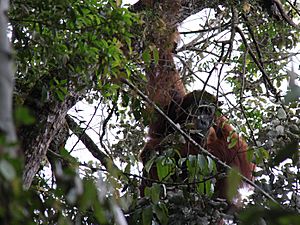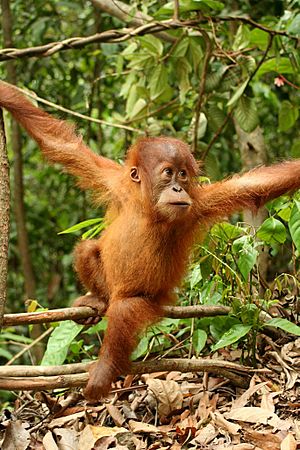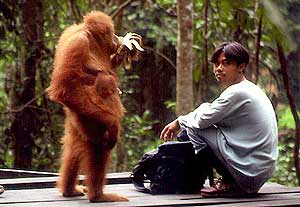Sumatran orangutan facts for kids
Quick facts for kids Sumatran orangutan |
|
|---|---|
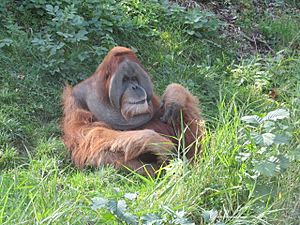 |
|
| Male at Leipzig Zoological Garden, Leipzig | |
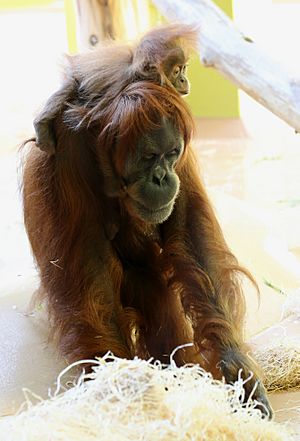 |
|
| Female with infant at the Tierpark Hellabrunn, Munich | |
| Conservation status | |
| Scientific classification | |
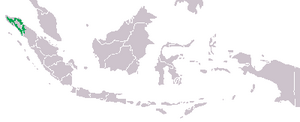 |
|
| Distribution in Indonesia |
The Sumatran orangutan (Pongo abelii) is one of three types of orangutans. You can only find them in the northern part of the Indonesian island of Sumatra. They are rarer than the Bornean orangutan but more common than the Tapanuli orangutan, which also lives in Sumatra.
The name "orangutan" comes from two Malay words: "orang" meaning "person" and "hutan" meaning "forest". So, an orangutan is a "person of the forest."
Contents
About Sumatran Orangutans
Male and female Sumatran orangutans look different, which is called sexual dimorphism. Males can grow to about 1.7 meters (5.6 feet) tall and weigh around 90 kilograms (200 pounds). Females are smaller, usually about 90 centimeters (3 feet) tall and weighing 45 kilograms (100 pounds).
Compared to orangutans from Borneo, Sumatran orangutans are thinner. They also have longer faces and lighter red hair.
Orangutan Behavior and Habitat
Sumatran orangutans eat more fruit and insects than Bornean orangutans. They especially love figs and jackfruits. They also eat bird eggs and small animals. They spend less time eating tree bark.
Wild Sumatran orangutans have been seen using tools. They break off a tree branch, snap off twigs, and chew one end. They use this stick to dig for termites in tree holes. They also use sticks to get honey from bee nests.
Orangutans even use tools to eat certain fruits. The Neesia fruit has a hard shell that opens when ripe. Inside are seeds they love, but they are covered in painful, fiberglass-like hairs. Orangutans make special sticks to carefully remove these hairs before eating the seeds. They often save useful tools and collect a "toolbox."
Filmmakers once showed a Sumatran orangutan using a twig to get food from tricky spots. Another orangutan was seen using a large leaf as an umbrella during a rainstorm!
Orangutans are the heaviest animals that travel through trees. They move slowly and carefully, using many branches for support. They can even sway trees to help them move.
Sumatran orangutans spend more time in trees than their Bornean relatives. This might be because of large predators like the Sumatran tiger on the ground. They move through trees by climbing with all four limbs and by swinging.
Scientists have found that orangutans use 64 different gestures to communicate. About 29 of these gestures have specific meanings that other orangutans understand. These gestures can mean things like "let's play," "stop that," or "share food." Sumatran orangutans mostly use gestures to communicate, not sounds.
Life Cycle of Sumatran Orangutans
Sumatran orangutans go through five main life stages:
- Infancy: From birth to about 2.5 years old. Babies weigh 2 to 6 kilograms (4.4 to 13 pounds). They have light patches around their eyes and mouth. The mother always carries them, feeds them, and they sleep in her nest.
- Juvenile-hood: From 2.5 to 5 years old. They weigh 6 to 15 kilograms (13 to 33 pounds). They are still carried by their mother but start to play with other young orangutans. They also take short trips nearby. By the end of this stage, they build their own nest close to their mother's.
- Adolescence: From 5 to 8 years old. They weigh 15 to 30 kilograms (33 to 66 pounds). The light patches on their face disappear. They stay close to their mothers but play more with friends in groups. They are careful around adult males.
- Sub-adulthood (males only): From 8 to 13 or 15 years old. Males weigh 30 to 50 kilograms (66 to 110 pounds). Their faces are dark, and they start to grow cheek pads and a beard. They are old enough to reproduce but still avoid adult males.
- Adulthood (males): From 13 to 15 years old. Males are very large, weighing 50 to 90 kilograms (110 to 200 pounds). They have a full beard and large cheek pads. They are fully grown and usually travel alone.
Female Sumatran orangutans typically live 44–53 years in the wild. Males live a bit longer, 47–58 years. Females can have babies up to 53 years old.
Sumatran orangutans are more social than Bornean orangutans. Groups gather to eat large amounts of fruit from fig trees. Adult males usually avoid other adult males. Young males try to mate with any female, but older females can easily stop them. Mature females prefer to mate with mature males.
It takes a long time for Sumatran orangutans to have babies again, about 9.3 years between births. This is the longest time among all great apes. Baby orangutans stay close to their mothers for up to three years. Even after that, they still spend time with their mothers. Both Sumatran and Bornean orangutans can live for more than 50 years.
The oldest orangutan in captivity, Inji, celebrated her 59th birthday at the Oregon Zoo in 2019.
What Sumatran Orangutans Eat
Sumatran orangutans mainly eat fruit, especially those with a large seed and fleshy part, like durians, lychees, jackfruit, and figs. Insects are also a big part of their diet, especially ants.
Their diet includes five main types of food:
- Fruits
- Insects
- Leaves
- Bark
- Other foods
Studies show that orangutans in one area of Indonesia ate over 92 different kinds of fruit, 13 kinds of leaves, and 22 other plant materials. They also ate at least 17 different types of insects. Sometimes, they even ate small amounts of soil from termite mounds.
When there isn't much ripe fruit, Sumatran orangutans will sometimes eat the meat of a slow loris, which is a small animal active at night. They get water from natural bowls in trees or by licking water from their arms when it rains.
Eating Meat
Eating meat is rare for Sumatran orangutans. When they do eat meat, it's usually a slow loris. This happens more often when there is not enough fruit. Like many other primates, orangutans usually only share meat between a mother and her baby.
Orangutan Genetics
| NCBI genome ID | 325 |
|---|---|
| Ploidy | diploid |
| Genome size | 3,441.24 Mb |
| Number of chromosomes | 24 pairs |
| Year of completion | 2011 |
Orangutans have 48 chromosomes. In 2011, scientists mapped out the entire genetic code (genome) of a Sumatran orangutan named Susie. This made the Sumatran orangutan the third great ape species, after humans and chimpanzees, to have its genome sequenced.
Scientists also studied the genes of wild orangutans from Borneo and Sumatra. They found that Bornean orangutans have less genetic diversity than Sumatran ones. This research showed that the two species separated about 400,000 years ago.
Protecting Sumatran Orangutans
Dangers They Face
Sumatran orangutans face many dangers. Forests are being cut down for wood (logging), and to make space for farms and palm oil plantations. Roads also break up their forest homes. In the 1990s, forests that were home to at least 1,000 orangutans were lost every year in one area alone.
By 2017, about 82.5% of Sumatran orangutans lived only in the northern part of Sumatra, in the Aceh Province. Only one population, in Pakpak Barat, is expected to survive long-term given the current threats.
Hunting is not a huge problem, but some local hunting does happen. In the past, people in Northern Sumatra hunted them for food. Farmers also see orangutans as pests if they damage crops and might try to get rid of them. In the 20th century, zoos and other places in Europe and North America also wanted live or dead orangutans, which led to some hunting.
Sumatran orangutans have strong hearts and lungs. However, they can get a lung infection called air sacculitis, which is similar to strep throat in humans. This infection is becoming more common in orangutans in zoos because they are exposed to human germs. In 2014, a Sumatran orangutan died from this infection, which was a concern because human medicine usually cures it.
Conservation Status
The Sumatran orangutan is only found in the north of Sumatra. They used to live in more places in Sumatra, but now they are mostly found in the Nanggroe Aceh Darussalam province.
Small groups also live near Lake Toba in the North Sumatra province. Two important areas for them are Bukit Lawang and Gunung Leuser National Park. Bukit Lawang is a village near Gunung Leuser National Park. In the 1970s, a group set up a sanctuary there to help orangutans rescued from logging. They taught the orangutans how to live in the wild again. Now, the sanctuary no longer takes new orangutans because the program has been successful, and the forest is full.
Since 2000, the Sumatran orangutan has been listed as critically endangered on the IUCN Red List. This means they are at very high risk of becoming extinct.
A survey in 2016 estimated there were about 14,613 Sumatran orangutans in the wild, which was double earlier estimates. In 2004, it was thought there were only about 7,300. Many of them live in protected areas like Gunung Leuser National Park, but some live in unprotected areas. A successful breeding program has also started in Bukit Tiga Puluh National Park.
Two main ways to help these orangutans are:
- Helping rescued or displaced orangutans return to the wild.
- Protecting their forest homes from logging and hunting.
Protecting their habitat is better for the long-term survival of the orangutans and costs less. The World Wide Fund for Nature and other groups are working to stop the clearing of forests near Bukit Tigapuluh National Park.
Orangutans need large areas to live and move around. They travel between different forest areas depending on where fruit is available. When forests are cut down or broken up, it stops them from moving freely. Sumatra currently has one of the fastest rates of deforestation in the world.
See also
 In Spanish: Orangután de Sumatra para niños
In Spanish: Orangután de Sumatra para niños





